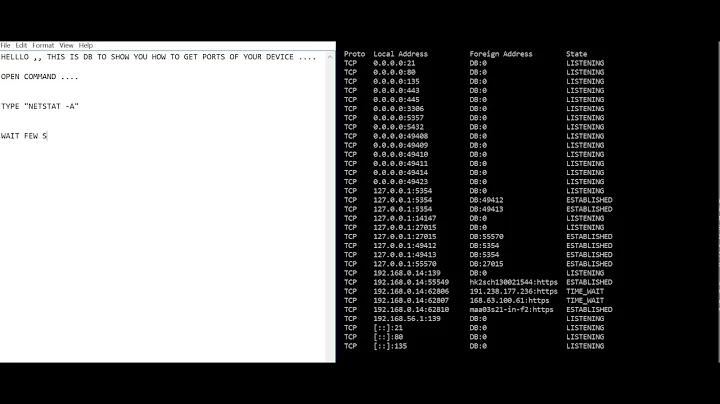On localhost, how do I pick a free port number?
Solution 1
Do not bind to a specific port. Instead, bind to port 0:
import socket
sock = socket.socket()
sock.bind(('', 0))
sock.getsockname()[1]
The OS will then pick an available port for you. You can get the port that was chosen using sock.getsockname()[1], and pass it on to the slaves so that they can connect back.
sock is the socket that you created, returned by socket.socket.
Solution 2
For the sake of snippet of what the guys have explained above:
import socket
from contextlib import closing
def find_free_port():
with closing(socket.socket(socket.AF_INET, socket.SOCK_STREAM)) as s:
s.bind(('', 0))
s.setsockopt(socket.SOL_SOCKET, socket.SO_REUSEADDR, 1)
return s.getsockname()[1]
Solution 3
Bind the socket to port 0. A random free port from 1024 to 65535 will be selected. You may retrieve the selected port with getsockname() right after bind().
Solution 4
If you only need to find a free port for later use, here is a snippet similar to a previous answer, but shorter, using socketserver:
import socketserver
with socketserver.TCPServer(("localhost", 0), None) as s:
free_port = s.server_address[1]
Note that the port is not guaranteed to remain free, so you may need to put this snippet and the code using it in a loop.
Solution 5
You can listen on whatever port you want; generally, user applications should listen to ports 1024 and above (through 65535). The main thing if you have a variable number of listeners is to allocate a range to your app - say 20000-21000, and CATCH EXCEPTIONS. That is how you will know if a port is unusable (used by another process, in other words) on your computer.
However, in your case, you shouldn't have a problem using a single hard-coded port for your listener, as long as you print an error message if the bind fails.
Note also that most of your sockets (for the slaves) do not need to be explicitly bound to specific port numbers - only sockets that wait for incoming connections (like your master here) will need to be made a listener and bound to a port. If a port is not specified for a socket before it is used, the OS will assign a useable port to the socket. When the master wants to respond to a slave that sends it data, the address of the sender is accessible when the listener receives data.
I presume you will be using UDP for this?
Related videos on Youtube
Anton L.
Updated on December 26, 2021Comments
-
Anton L. over 2 years
I'm trying to play with inter-process communication and since I could not figure out how to use named pipes under Windows I thought I'll use network sockets. Everything happens locally. The server is able to launch slaves in a separate process and listens on some port. The slaves do their work and submit the result to the master. How do I figure out which port is available? I assume I cannot listen on port 80 or 21?
I'm using Python, if that cuts the choices down.
-
 David Z almost 15 yearsIncidentally, if you just pick a random or random-ish port number (preferably higher than 1024), it'll probably be available. You can even use port 80 or 21 or whatever, as long as no other program is listening on it. At any given time, on a normal system, only a small fraction of ports are in use.
David Z almost 15 yearsIncidentally, if you just pick a random or random-ish port number (preferably higher than 1024), it'll probably be available. You can even use port 80 or 21 or whatever, as long as no other program is listening on it. At any given time, on a normal system, only a small fraction of ports are in use. -
Corehpf almost 15 yearsPicking a random port is not a good idea - let the OS pick one for you.
-
 Ciro Santilli OurBigBook.com over 8 yearsOn POSIX: stackoverflow.com/questions/913501/…
Ciro Santilli OurBigBook.com over 8 yearsOn POSIX: stackoverflow.com/questions/913501/…
-
-
cevaris over 8 yearsSee stackoverflow.com/a/2838309/3538289 for an example of
sock.bind(('',0)) -
Sebastian over 8 yearsHow do you pass on the number to the slaves? Sounds like a chicken and egg problem to me.
-
mark4o over 8 yearsIf the slaves are created after binding, you can just pass it as a parameter when creating them. Alternatively you could write it to some shared memory or a file that both can access, or a central server accessed via some well known port number could keep track of it.
-
codeskyblue over 6 yearsif on localhost: maybe
s.bind(('localhost', 0))is better -
jonEbird about 6 yearsAlso good to add the following so you can quickly re-use that port before your return statement:
s.setsockopt(socket.SOL_SOCKET, socket.SO_REUSEADDR, 1) -
Karl Bartel over 4 years@jonEbird Does
socket.SO_REUSEADDRreally help in this case? From what I read, it is only relevant that the socket which is trying to bind hasSO_REUSEADDRand it is irrelevant whether that flag is set on the lingering socket. -
 Charlie Parker over 3 yearswhat is
Charlie Parker over 3 yearswhat issock? can you show a full example with an import statement please? -
user26742873 almost 3 years@Sebastian It depends on your case, and is troubling to discuss generally. In my case I just store it in a local text file.
-
hldev over 2 years@KarlBartel in linux the subprocess will be able to reuse the given addr only if it was bound with
SO_REUSEADDR. I tried not usingSO_REUSEADDRand the subprocess (google chrome browser) gotEADDRINUSEerror. -
Jonathan Liuti over 2 yearsThis solution is simpler and implies less code but it is also significantly slower than the accepted answer. Accepted answer gives -> 20.2 µs ± 1.5 µs per loop (mean ± std. dev. of 7 runs, 10,000 loops each) This solution gives -> 191 µs ± 3.41 µs per loop (mean ± std. dev. of 7 runs, 10,000 loops each) ```








